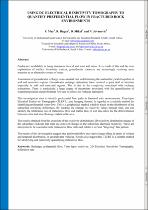 ResearchSpace
ResearchSpace
Using DC electrical resistivity tomography to quantify preferential flow in fractured rock environments
JavaScript is disabled for your browser. Some features of this site may not work without it.
- ResearchSpace
- →
- Research Publications/Outputs
- →
- Conference Publications
- →
- View Item
| dc.contributor.author |
May, F

|
|
| dc.contributor.author |
Bugan, Richard DH

|
|
| dc.contributor.author |
Mikes, D

|
|
| dc.contributor.author |
Jovanovic, Nebojsa

|
|
| dc.date.accessioned | 2012-01-06T08:58:13Z | |
| dc.date.available | 2012-01-06T08:58:13Z | |
| dc.date.issued | 2011-09 | |
| dc.identifier.citation | May, F., Bugan, R., Mikes, D. and Jovanovic, N. 2011. Using DC electrical resistivity tomography to quantify preferential flow in fractured rock environments. International Conference on Groundwater: Our source of security in an uncertain future, CSIR International Convention Centre, Pretoria, South Africa, 19-21 September 2011 | en_US |
| dc.identifier.uri | http://gwd.org.za/sites/gwd.org.za/files/list_papers_posters_accepted_march_2011.pdf | |
| dc.identifier.uri | http://hdl.handle.net/10204/5440 | |
| dc.description | International Conference on Groundwater: Our source of security in an uncertain future, CSIR International Convention Centre, Pretoria, South Africa, 19-21 September 2011 | en_US |
| dc.description.abstract | Freshwater availability is being threatened in arid and semi arid areas. As a result of this and the over exploitation of surface freshwater sources, groundwater resources are increasingly receiving more attention as an alternative source of water. This investigation aims to identify preferential flow paths in fractured rock environments. Time-lapse Electrical Resistivity Tomography (TLERT, Lund Imaging System), is regarded as a suitable method for identifying preferential water flow. | en_US |
| dc.language.iso | en | en_US |
| dc.relation.ispartofseries | Workflow request;7831 | |
| dc.subject | Preferential flow | en_US |
| dc.subject | Time lapse resistivity | en_US |
| dc.subject | 2D electrical resistivity tomography | en_US |
| dc.subject | Infiltration rate | en_US |
| dc.subject | Fractured rocks | en_US |
| dc.subject | Groundwater | en_US |
| dc.subject | Freshwater | en_US |
| dc.title | Using DC electrical resistivity tomography to quantify preferential flow in fractured rock environments | en_US |
| dc.type | Conference Presentation | en_US |
| dc.identifier.apacitation | May, F., Bugan, R. D., Mikes, D., & Jovanovic, N. (2011). Using DC electrical resistivity tomography to quantify preferential flow in fractured rock environments. http://hdl.handle.net/10204/5440 | en_ZA |
| dc.identifier.chicagocitation | May, F, Richard DH Bugan, D Mikes, and Nebojsa Jovanovic. "Using DC electrical resistivity tomography to quantify preferential flow in fractured rock environments." (2011): http://hdl.handle.net/10204/5440 | en_ZA |
| dc.identifier.vancouvercitation | May F, Bugan RD, Mikes D, Jovanovic N, Using DC electrical resistivity tomography to quantify preferential flow in fractured rock environments; 2011. http://hdl.handle.net/10204/5440 . | en_ZA |
| dc.identifier.ris | TY - Conference Presentation AU - May, F AU - Bugan, Richard DH AU - Mikes, D AU - Jovanovic, Nebojsa AB - Freshwater availability is being threatened in arid and semi arid areas. As a result of this and the over exploitation of surface freshwater sources, groundwater resources are increasingly receiving more attention as an alternative source of water. This investigation aims to identify preferential flow paths in fractured rock environments. Time-lapse Electrical Resistivity Tomography (TLERT, Lund Imaging System), is regarded as a suitable method for identifying preferential water flow. DA - 2011-09 DB - ResearchSpace DP - CSIR KW - Preferential flow KW - Time lapse resistivity KW - 2D electrical resistivity tomography KW - Infiltration rate KW - Fractured rocks KW - Groundwater KW - Freshwater LK - https://researchspace.csir.co.za PY - 2011 T1 - Using DC electrical resistivity tomography to quantify preferential flow in fractured rock environments TI - Using DC electrical resistivity tomography to quantify preferential flow in fractured rock environments UR - http://hdl.handle.net/10204/5440 ER - | en_ZA |





